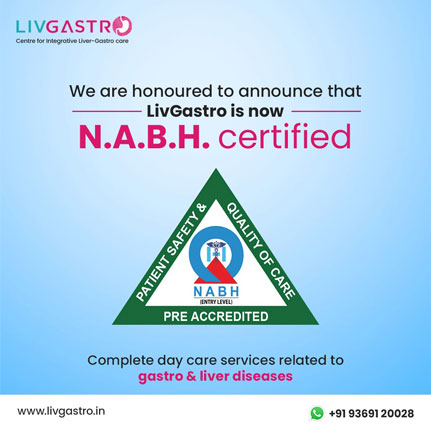
Team LivGastro provides utility based model of care that integrates specialists, primary care , laboratory, imaging and other health services to give patients a convenient and superior outcome along with a pleasant experience. Since we primarily focus on outdoor-patient care, on the site instant testing along with detailed and accurate results, we enable our patients and their families save
a lot of effort, time and money.
A fistula is an atypical, tube-type connection between a set of organs lined with epithelial cells. However, there are several types of fistulas, such as:
Fistulas, however, are caused due to various reasons, while artificial fistulas are sometimes created for therapeutic purposes, such as, Hemodialsis Fistulas that are surgically created communications between native artery and vein and are commonly called AVFs as cited above. Polytetrafluoroethylene (PTFE) and other materials (Dacron, polyurethane, bovine vessels, saphenous veins) are used (or have been used) as a communication medium between the artery and the vein and are termed prosthetic hemodialysis access arteriovenous grafts (AVGs). The access that is created is routinely used for hemodialysis several times a week.
Instances of naturally occurring fistulas include those that form between the end of the bowel and skin adjacent to the anus, known as Anal Fistula, while those that form between the intestine and the vagina are called Enterovaginal Fistula. With women, fistula may also form between the rectum and the vagina that are termed as Rectovaginal Fistula.
Gastrointestinal fistula, as earlier defined, is an abnormal opening in the digestive tract that allows gastric juices to seep through the lining of the stomach or intestines, often resulting in infection when coming in contact with the skin or other vital organs of the body. Persons suffering from chronic digestive diseases run a high risk of developing gastrointestinal fistula, while intra-abdominal surgery also often gives rise to GIF.
However, gastrointestinal fistulas fall under the following four categories, such as:
Even though gastrointestinal fistulas reportedly develop after intra-abdominal surgery, there are also a few other issues that can be linked to it, such as:
The gastrointestinal fistula may also develop without any known reason (around 15 to 25 percent) and so is called Spontaneous formation. Besides, inflammatory bowel disorders, such as Crohn’s Disease, Bowel Infections such as Diverticulitis, vascular insufficiencies, or poor blood flow cause GIF too. Sometimes trauma can give rise to GIF (though rather rare).
GIF symptoms include both internal as well as external fistulas. External GIF causes discharge through the skin and include:
People who have internal fistulas are likely to experience:
The gravest GIF complication is Sepsis, a medical emergency in which the body reacts dangerously to bacteria that invariably leads to perilously low blood pressure, organ damage and death.
Your doctor will first review your medical and surgical history and assess your current symptoms and run several blood tests to help diagnose a GIF.
These blood tests will often assess your serum electrolytes and nutritional status, which is a measure of your levels of albumin and pre-albumin. These are both proteins that play an important role in wound healing.
If the fistula is external, the discharge may be sent to a laboratory for analysis. A fistulogram may be done by injecting contrast dye into the opening in your skin and taking X-rays.
Finding internal fistulas can be more difficult. Your doctor may run these tests: An upper and lower endoscopy involves the use of a thin, flexible tube with the help of an endoscope to view possible problems in your digestive or gastrointestinal tract.
Upper and lower intestinal radiography with contrast medium may also be used. This can include a barium swallow if your doctor thinks you might have a stomach or intestinal fistula. A barium enema may be used if your doctor thinks you have a colon fistula.
An ultrasound or CT scan can be used to find intestinal fistula or abscessed areas. A fistulogram involves injecting a contrast dye into the opening of your skin in an external fistula and then taking X-ray images.
For a fistula involving the major ducts of your liver or pancreas, a special imaging test called a magnetic resonance cholangiopancreatography (MRCP) may be used.
Your doctor will do a thorough assessment of your fistula to determine the likelihood of it closing on its own.
Fistulas are classified based on how much gastric fluid is seeping through the opening. Low output fistulas produce less than 200 milliliters of gastric fluid per day. High output fistulas produce about 500 milliliters per day.
Some types of fistulas close on their own when:
Your Treatment may include:
GIF treatment can take weeks or even months. Your doctor may recommend surgically closing your fistula if you haven’t improved after three to six months of treatment.
